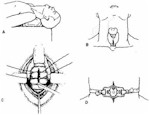|
Medical Education Division |
Operational Medicine 2001
Emergency War Surgery
Second United States Revision of The Emergency War Surgery NATO
Handbook
United States Department of Defense
Emergency War Surgery
Second United States Revision of The Emergency War Surgery NATO Handbook
United States Department of Defense
Home · Military Medicine · Sick Call · Basic Exams · Medical Procedures · Lab and X-ray · The Pharmacy · The Library · Equipment · Patient Transport · Medical Force Protection · Operational Safety · Operational Settings · Special Operations · Humanitarian Missions · Instructions/Orders · Other Agencies · Video Gallery · Phone Consultation · Forms · Web Links · Acknowledgements · Help · Feedback
|
Emergency War Surgery NATO Handbook: Part IV: Regional Wounds and Injuries: Chapter XXVII: Wounds and Injuries of the Neck Emergency TracheostomyUnited States Department of Defense Tracheostomy as a lifesaving procedure has proven its worth many times over (Figure 32); however, tracheostomy requires a thorough knowledge of anatomy and must be performed many times before it can be done both quickly and safely. Adequate lighting is essential. Positioning is also very important in tracheostomy. The patient lies supine, with the shoulders elevated by sandbags or folded towels, so that the neck is extended. Local anesthesia is usually utilized. The incision may be longitudinal or transverse. The transverse incision will insure a better cosmetic result, but the longitudinal incision is almost bloodless and there is more rapid exposure of the trachea with it. It is made in the midline, through the skin and platysma, from the cricoid cartilage to the suprasternal notch. The strap muscles are separated in the midline by blunt dissection. When they are retracted, the trachea is exposed. If the isthmus of the thyroid is encountered. it is displaced upward or downward. Local anesthesia, in the amount of 1-2 cc, is injected into the tracheal lumen to reduce the cough reflex. The pretracheal fascia is incised and stripped laterally as necessary to expose the underlying cartilages. The ideal level at which to incise the trachea is at the level of the second, third, and fourth tracheal rings. The trachea is retracted with a hook between the cricoid and first ring while a vertical incision is made through three tracheal rings. The incision should be made long enough to accommodate the diameter of the tube to be inserted. A heavy silk suture, passed through each side of the incised trachea, may later be used as a retractor and guide to facilitate early tracheostomy tube changes. The adult male trachea can easily accommodate a size 6-9 tracheostomy tube. Smaller tubes cause airway resistance and can lead to hypoxia. Position and secure the tube. The skin incision does not require closure. Suction should be available at operation to remove secretions from the trachea. If it is not available, the head should be lowered as soon as the trachea has been opened. Complications associated with tracheostomy are more frequent than realized and should be mentioned:
Approved for public release; Distribution is unlimited. The listing of any non-Federal product in this CD is not an endorsement of the product itself, but simply an acknowledgement of the source. Operational Medicine 2001 Health Care in Military Settings
This web version is provided by The Brookside Associates Medical Education Division. It contains original contents from the official US Navy NAVMED P-5139, but has been reformatted for web access and includes advertising and links that were not present in the original version. This web version has not been approved by the Department of the Navy or the Department of Defense. The presence of any advertising on these pages does not constitute an endorsement of that product or service by either the US Department of Defense or the Brookside Associates. The Brookside Associates is a private organization, not affiliated with the United States Department of Defense. |
